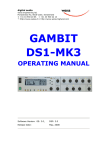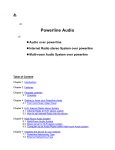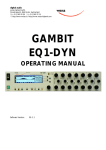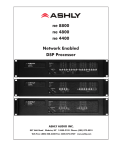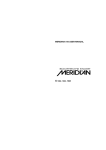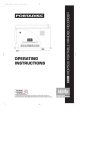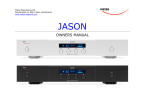Download WEISS GAMBIT ADC2 Operating instructions
Transcript
digital audio weiss engineering ltd. Florastrasse 42, 8610 Uster, Switzerland +41 44 940 20 06 +41 44 940 22 14 http://www.weiss.ch / http://www.weiss-highend.com WEISS GAMBIT ADC2 OPERATING MANUAL Software Version: 3.1 Firewire option update 12.10.2011 OPERATING INSTRUCTIONS FOR GAMBIT ADC2 24Bit / 192kHz A/D CONVERTER INTRODUCTION INTRODUCTION Congratulations on purchasing the Weiss Gambit Series ADC2 A/D Converter ! The ADC2 is a two channel A/D converter designed for most demanding audio applications. It uses state of the art A/D chips in Weiss Engineering’s proven “correlation technique” configuration, which lowers converter imperfections and improves the SNR ratio. Summary of ADC2 features: For best noise rejection, the analogue input signal is kept balanced from the input connectors up to the converter chips. A high quality microphone preamp is available as a standard feature. • Two balanced LINE and two MIC inputs on separate XLR connectors. • MIC input with switchable phantom power. • Input sensitivity is settable in each channel independently (or ganged) with two rotary encoders. • Line Input sensitivity: -16dBu to +26 dBu. • Mic Input sensitivity: -54dBu to +6dBu. • Separate AES/EBU input on XLR for synchronization and/or audio input to the DSP, which allows for use of the ADC2 for redithering and limiting of digital signals. Additionally, there is a built-in digital two-segment compressor / limiter for optimal levelling, employing adaptive release timing, look-ahead circuitry and sidechain-oversampling for mastering-quality dynamics processing. Large bar graphs, a well thought-out push button array and uncluttered rotary knobs optimize handling ergonomics. Inputs Synchronization • Internal sync selectable 44.1kHz, 48kHz, 88.2kHz, 96kHz, 176.4kHz, 192kHz. • External sync from Wordsync Input (BNC) or from AES/EBU input. • Wordsync output on a BNC connector. Metering • One input / output level bargraph per channel with short peak hold • One gain reduction bargraph per channel. • Two over LEDs • Two numerical displays for peak hold and level settings. • Reference for level setting can be altered Daniel Weiss Engineering Ltd., Florastr. 42, CH-8610 Uster +41 44 940 20 06 +41 44 940 22 14 http://www.weiss. ch [email protected] Page 2 OPERATING INSTRUCTIONS FOR GAMBIT ADC2 24Bit / 192kHz A/D CONVERTER INTRODUCTION Outputs • AES/EBU on XLR in one or two wire format • S/PDIF on RCA • Firewire (Optional, a kit is available) DSP • POW-R dithering to 16 bits, settable to three different algorithms according to the POW-R standard • SNR enhancement • Level bar graph meter • Two segment compressor / peak limiter • Double-precision 40bit floating-point processing Daniel Weiss Engineering Ltd., Florastr. 42, CH-8610 Uster +41 1 940 20 06 +41 1 940 22 14 http://www.weiss. ch [email protected] Page 3 OPERATING INSTRUCTIONS FOR GAMBIT ADC2 24Bit / 192kHz A/D CONVERTER OPERATION OPERATION ADC2 Block Diagram Fig. 1 ADC2 Block Diagram Schematic 1 Input Control Panel compressor / limiter links the sidechains of the two channels. Typical applications for “ganged” mode are This section describes how to use the input control panel (see Fig. 2). • stereo (left/right) recordings with two microphones • stereo insert limiting (during mixdown or mastering). Fig. 2 ADC2 Input Control Panel If “ganged” is not active, channel 1 and channel 2 settings are independent and the compressor / limiter works unlinked. Thus the ADC2 can also be used in a studio recording / mixing environment as dual channel outboard compressor / limiter. Ganged For stereo use, press the “ganged” key. This locks together channel 1 and channel 2 gain and threshold controls. Additionally, if “ganged” is active, the 1 “sidechain linking ” means that the same gain reduction is applied to both channels to avoid corrupting the stereo balance. Daniel Weiss Engineering Ltd., Florastr. 42, CH-8610 Uster +41 1 940 20 06 +41 1 940 22 14 http://www.weiss. ch [email protected] Page 4 OPERATING INSTRUCTIONS FOR GAMBIT ADC2 24Bit / 192kHz A/D CONVERTER OPERATION Pressing the “digtial in” key activates the digital AES/EBU XLR input, the key lights red if active. As soon as a valid signal is present, the sampling rate is displayed with the sampling rate keys (see Fig. 6). The level bargraph is switched between input and output in the same manner as the peak hold. Thus, if the “input gain” key is lit, the bargraph displays the input peak meter. If the “output gain” key is lit, the bargraph displays the ouput peak meter (settings can be different if “ganged” is not lit). If the digital input stage does not lock to any signal, none of the sampling rate keys are lit. Refer to Fig. 1 on p. 4 for positioning of input and output peak meter in the processing chain. If the “digital in” key is not lit, the analogue inputs are selected. To activate the microphone input for either channel, press the appropriate “mic” key (if “ganged” is active, pressing one “mic” key will select microphone inputs for both channels). Press “+48V” if phantom power is needed. Note: The reference for the input sensitivity display can be chosen by the user. For that purpose press and hold the “ganged” key and then switch the ADC2 on. After a few seconds release the ganged key. Wait for a few more seconds. Now you can select the reference with the righthand knob. This allows to set the reference to e.g. +4dBu. Factory setting is 0 dBu reference. When finished press the blinking “peak hold” key. The setting is retained in non-volatile memory. Digital In / Mic It is usually advisable to use “low-cut” when recording with microphones. If “low-cut” is lit, low frequency content (traffic rumble, building tremors, air-condition hum and other low-frequency air movement like doors opening or closing near the microphone etc.) is filtered out. Peak Hold If “peak hold” is lit, the numeric display shows the peak hold value (in dBFS) which is selected by the gain key: “input gain” selects the input peak hold, “output gain” selects the output peak hold (“threshold” also selects output peak hold). See Fig. 1 for positioning of input and output peak hold in the processing chain. If input peak hold is selected, values equal to or above 0.0dBFS are indicated by “>=0”. The output peak hold however can measure values above 0.0dBFS because of the internal floating-point data format used in the digital signal processor. This is very useful to set the output gain. Output Gain If “output gain” is lit, the rotary knobs control the digital output gain. This gain can be used for optimal gain adjustment and to drive the peak limiter (see below). The gain ranges from -∞ (off) to +18.0 dB, the resolution is optimized for fine control around 0.0 dB while still allowing complete fade-out. A special algorithm is used for click-free gain transitions (no “zipper” noise). To clear the peak hold value, double-click the “peak hold” key! Double-click resets both input and output peak hold. Input Gain If “input gain” is lit, the rotary knobs control the analogue input sensitivity. This is adjusted in 1dB steps via a relay controlled attenuator. The selected value is shown in the numeric display. Daniel Weiss Engineering Ltd., Florastr. 42, CH-8610 Uster +41 1 940 20 06 +41 1 940 22 14 http://www.weiss. ch [email protected] Page 5 OPERATING INSTRUCTIONS FOR GAMBIT ADC2 24Bit / 192kHz A/D CONVERTER OPERATION Threshold If “threshold” is lit, the rotary knobs control the threshold of the compressor section. The value is shown in the numeric display. If “peak hold” is active, the output peak value is displayed. 0.0 The ADC2 has a two-segment dynamics compressor. The threshold can only be adjusted for the compressor section, which has a fixed ratio of 2:1. -6.0 The limiter has a fixed ratio of ∞:1 with a fixed threshold of 0.0 dBFS. -12.0 -12.0 Because the signal before the output gain never exceeds 0.0dBFS, the limiter is inactive if the output gain is 0.0dB. -6.0 0.0 +6.0 Fig. 4 Compressor with -3.0dB Threshold If the threshold is set to 0.0 and the output gain is below 0.0 the dynamics section is inactive. This setup is shown in the input vs. output graph in Fig. 3. 0.0 -6.0 0.0 -12.0 -12.0 -6.0 -12.0 -12.0 -6.0 0.0 +6.0 Fig. 3 Compressor with 0.0dB Threshold To activate the limiter, set the output gain to a positive value. The boost will drive the signal into the limiter. The gain reduction applied by the limiter is visible on the yellow bargraphs. -6.0 0.0 +6.0 Fig. 5 Compressor with -6.0dB Threshold The overall gain reduction applied by the compressor / limiter is shown in the yellow bargraph. Note that the compressor uses auto gain make-up: depending on the threshold, a gain is added after the compressor to ensure that 0.0 dBFS input results in 0.0 dBFS output (graphically speaking, auto gain make-up “fixes” the transfer curve at the (0.0, 0.0) point). To soften the transmission from linear to limiter segment, the compressor can be activated by adjusting the threshold parameter. Fig. 4 shows a setting with a threshold of –3 dBFS, Fig. 5 shows –6 dBFS. The range of possible threshold values is listed on p. 14. Daniel Weiss Engineering Ltd., Florastr. 42, CH-8610 Uster +41 1 940 20 06 +41 1 940 22 14 http://www.weiss. ch [email protected] Page 6 OPERATING INSTRUCTIONS FOR GAMBIT ADC2 24Bit / 192kHz A/D CONVERTER POW-r Dither Sync and Dither Control Panel Fig. 6 ADC2 Sync and Dither Control Panel Sampling Frequency If the analogue inputs are selected (“digital in” is not lit), the A/D sampling frequency can be set in the sync source block: Sampling Frequency OPERATION 44.1 / 48 kHz key fs x 2 / fs x 4 key 44.1 kHz 44.1 kHz none 48.0 kHz 48 kHz none 88.2 kHz 44.1 kHz sf x 2 96.0 kHz 48 kHz sf x 2 176.4 kHz 44.1 kHz sf x 4 192.0 kHz 48 kHz sf x 4 Table 1 Samplig Frequency Selection If “digital in” is lit, the sampling frequency keys display the sampling frequency of the AES/EBU input signal in the same fashion as is shown in Table 1. To requantize the input signal from 24bit to 16bit format, a special technique is used to avoid distortion, called dithering. Many dithering schemes are available today, both professional and homebrewed. The ADC2 uses the POW-r scheme, which is widely regarded as 2 one of the best, if not the best , and is used in a variety of digital equipment. The POW-r scheme offers three different presets which can be selected with the dither keys “pow-r 1”, “pow-r 2” and “pow-r 3”. The choice should be based on listening tests and preference of the recording engineer. 3 Dithering is in “auto black” mode: if digital zero is detected at the ouput, dithering is switched off. This ensures that programme breaks are not filled with dither noise. “Auto black” mode is not available for analogue input signals. Also note the effect of the “DITHER MODE” dip switch setting in Fig. 1 ADC2 Block Diagram Schematic. If the dip switch is in the down position, requantisation to 16 bit and dithering is only applied to the S/PDIF RCA output, whereas the AES/EBU XLR output still carries all 24bits. This mode is useful for live recording to a 24bit device with simultaneous backup to a 16bit device (like DAT or CD-R). If the dip switch is in the up position, all digital outputs are dithered to 16bits. Sync Source As can be seen in Fig. 1, the ADC2 can be synchronized externally by other digital devices. It has two external sync inputs. External sync is only available for analogue inputs, ie “digital in” key is not lit. If “AES” is lit, the AES/EBU signal at the “DI 1 / SYNC” input is used for synchronization. If “BNC” is lit, the wordclock signal connected to “WORDSYNC in” is used for synchronization. Both sync inputs have a loopthrough ouput to syncronize other devices. If none of these two keys are lit, the ADC2 uses internal sync. 2 For reviews of POW-r visit www.weiss.ch 3 The term “black” comes from digital image formats, where black is represented by the value zero. Daniel Weiss Engineering Ltd., Florastr. 42, CH-8610 Uster +41 1 940 20 06 +41 1 940 22 14 http://www.weiss. ch [email protected] Page 7 OPERATING INSTRUCTIONS FOR GAMBIT ADC2 24Bit / 192kHz A/D CONVERTER Why dither? If the 24bit digital signal is not dithered when recording to 16bit media (e.g. DAT, CD-R etc), it is truncated instead, which leads to quantization distortion (similar to clipping distortion). Fig. 7 shows a 24bit sine wave at –85dBFS truncated to 16bit. Fig. 7 1kHz Sine wave truncated to 16bit OPERATION To view the frequency characteristics of the three POW-r algorithms, refer to POW-R Noise Spectrum on p. 15. For more information on dithering in general, view the article “The Secrets of Dither” at www.digido.com . For more POW-r information, please visit www.weiss.ch/pow-r/pow-r.html . If the same sine wave is dithered instead of quantized, the quantization distortion disappears and is replaced by wide band shaped noise, which is more pleasing to the human ear (Fig. 8). Fig. 8 1kHz sine wave dithered to 16bit Daniel Weiss Engineering Ltd., Florastr. 42, CH-8610 Uster +41 1 940 20 06 +41 1 940 22 14 http://www.weiss. ch [email protected] Page 8 OPERATING INSTRUCTIONS FOR GAMBIT ADC2 24Bit / 192kHz A/D CONVERTER OPERATION AES OUT DUAL WIRE Dip Switches AES OUT 2 WIRE DITHER MODE WSYNC TERM. AES IN TERM. If this switch is in the up position, the ADC2 outputs a dual-wire signal. Refer to Table 2 and Table 3 to look up exact output configurations depending on this dip switch. DO1 (XLR 1) DO2 (XLR 2) DO3 (RCA) 44.1 kHz 44.1 kHz single wire 44.1kHz single wire 44.1 kHz single wire Fig. 9 Dip switches at the rear of the ADC2 48 kHz 48 kHz single wire 48 kHz single wire 48 kHz single wire DIP switch summary: 88.2 kHz 44.1 kHz 44.1 kHz right muted left channel channel 1: 2: 3: 4: Sampling Freq. Switch up down 96 kHz 48 kHz 48 kHz left channel right channel 1 dual wire on XLR outputs single wire on XLR outputs (both carry the same signal) 176.4 kHz 88.2 kHz 88.2 kHz right muted left channel channel 192 kHz 96 kHz 96 kHz left channel right channel 2 dither setting affects dither setting affects all outputs only RCA output 3 WSYNC input on BNC NOT terminated WSYNC input on BNC terminated 4 AES/EBU input NOT terminated AES/EBU input terminated muted muted Table 2 AES OUT dual WIRE switch in up position Sampling Freq. DO1 (XLR 1) DO2 (XLR 2) DO3 (RCA) 44.1 kHz 44.1 kHz single wire 44.1kHz single wire 44.1 kHz single wire 48 kHz 48 kHz single wire 48 kHz single wire 48 kHz single wire 88.2 kHz 88.2 kHz single wire 88.2 kHz single wire 88.2 kHz single wire 96 kHz 96 kHz single wire 96 kHz single wire 96 kHz single wire 176.4 kHz 176.4 kHz single wire 176.4 kHz single wire 176.4 kHz single wire 192 kHz 192 kHz single wire 192 kHz single wire 192 kHz single wire Table 3 AES OUT dual WIRE switch in down position Daniel Weiss Engineering Ltd., Florastr. 42, CH-8610 Uster +41 1 940 20 06 +41 1 940 22 14 http://www.weiss. ch [email protected] Page 9 OPERATING INSTRUCTIONS FOR GAMBIT ADC2 24Bit / 192kHz A/D CONVERTER DITHER MODE This switch determines how dither is applied to XLR and RCA outputs. Refer to chapter POW-r Dither on p. 7 for further information. WSYNC TERM. If the “WORDSYNC in” is not connected to another device (via a T-connector), this dip switch must be in the down position, in which case the signal is properly terminated. If another unit is connected to the “WORDSYNC in”, this dip switch must be in the up position. Regardless of input synchronization type, the “WORDSYNC out” always carries the word sync used by the ADC2. AES IN TERM. If the loop-through output of the “DI 1 / SYNC” input is not connected to another device, this dip switch must be in the down position, in which case the line is properly terminated. If another unit is connected, this dip switch must be in the up position. FIREWIRE If the optional Firewire Interface kit is installed, the Firewire socket on the back of the unit becomes active. For the installation of the necessary driver software refer to the installation instruction file on the driver CD. The CD can be found on the last page of the manual, or download the latest driver from: OPERATION In the audio setup of your computer select the Weiss Firewire Interface as the recording and/or playback device. The recording path uses the ADC2 XLR output as input to the Firewire interface. The playback path feeds the data coming into the ADC2 via Firewire directly to the RCA output connector. There are no ADC2 processing features available for that path. I.e. it is possible to play a file on the computer via the ADC2 firewire interface to that RCA output. The RCA connector can be jumpered in the ADC2 unit to carry either the Firewire output or the standard ADC2 output as described in this manual. If the ADC2 comes with the Firewire option installed, the RCA connector is jumpered to the Firewire output. Note that the ADC2 is the masterclock even when using just the playback path. So make sure to set the ADC2 to the sampling rate of the file to be played back. It is possible to connect more than one ADC2 to the Firewire bus (use a Firewire hub or a computer with more than one Firewire connector to establish such a configuration). In such a case one of the ADC2 is the masterclock for the whole system, i.e. the slave ADC2 unit(s) have to be synchronized to the master ADC2 via e.g. the WORDSYNC (on BNC connectors) signal. In the Weiss Firewire IO panel the master ADC2 unit is selected (designated). All other ADC2 units on the Firewire bus then are automatically configured as slave units, i.e. their Firewire Interfaces are slaved to the Firwire bus. Despite that slaving via the Firewire bus, the aforementioned sync connections via WORDSYNC (or AES/EBU sync) have to be established. The slave ADC2 unit(s) have to be switched to external sync via the appropriate frontpanel switches. http://www.weiss.ch/downloads/index.php In the Weiss Firewire IO panel (the driver application) the ADC2 device will be visible once the Firewire connection has been established. The ADC2 becomes the masterclock for the Firewire data transfers, i.e. the Firewire interface will be automatically configured such that it is slaved to the ADC2 output. Daniel Weiss Engineering Ltd., Florastr. 42, CH-8610 Uster +41 1 940 20 06 +41 1 940 22 14 http://www.weiss. ch [email protected] Page 10 OPERATING INSTRUCTIONS FOR GAMBIT ADC2 24Bit / 192kHz A/D CONVERTER TECHNICAL DATA TECHNICAL DATA Analogue Line Inputs 2 channels, symmetrical, not earth free, on two XLR female connectors, pin 2 hot. Input Impedance > 5kOhm Analogue Microphone Inputs 2 channels, symmetrical, not earth free, on two XLR female connectors, pin 2 hot. Input Impedance > 5kOhm 48V phantom power switchable AES/EBU Input Input fs range: 44.1kHz 48.0kHz 88.2kHz 96.0kHz 176.4kHz 192.0kHz All sampling frequencies must lie within +- 100ppm of the nominal sampling frequency. Maximum Input Wordlength: Connector: Impedance: 24 Bits XLR female 110 Ohm AES/EBU Output Output fs range: 44.1kHz 48.0kHz 88.2kHz 96.0kHz 176.4kHz 192.0kHz Maximum Output Wordlength: Channel Status Data: Connector: Impedance: Format: 24 Bits Professional format two times XLR male 110 Ohm single wire or double wire for fs higher than 48kHz (switch selectable) Daniel Weiss Engineering Ltd., Florastr. 42, CH-8610 Uster +41 1 940 20 06 +41 1 940 22 14 http://www.weiss. ch [email protected] Page 11 OPERATING INSTRUCTIONS FOR GAMBIT ADC2 24Bit / 192kHz A/D CONVERTER TECHNICAL DATA S/PDIF Output Output fs range: 44.1kHz 48.0kHz 88.2kHz 96.0kHz 176.4kHz 192.0kHz Maximum Output Wordlength: Channel Status Data: Connector: Impedance: 24 Bits Professional format RCA female 75 Ohm WORDSYNC I/O Input Connector: Input Impedance: Input Level: BNC female 75 Ohm TTL Output Connector: Output Impedance: Output Level: BNC female 4.7 Ohm TTL Firewire (Optional, a kit is available) Power Mains Voltage: Fuse rating: Power Consumption: 110 / 220 Volts with voltage selector 0.63A slow blow 60VA max. Daniel Weiss Engineering Ltd., Florastr. 42, CH-8610 Uster +41 1 940 20 06 +41 1 940 22 14 http://www.weiss. ch [email protected] Page 12 OPERATING INSTRUCTIONS FOR GAMBIT ADC2 24Bit / 192kHz A/D CONVERTER TECHNICAL DATA Low cut frequency response: 1st order highpass, 3dB point at 40Hz Frequency Response: @ fs = 44.1kHz: 20Hz ... > 20kHz +- 0.3dB @ fs = 48.0kHz: 20Hz ... > 20kHz +- 0.3dB @ fs = 88.2kHz: 20Hz ... > 30kHz +- 0.3dB @ fs = 96.0kHz: 20Hz ... > 30kHz +- 0.3dB @ fs = 176.4kHz: 20Hz ... > 40kHz +- 0.3dB @ fs = 192.0kHz: 20Hz ... > 40kHz +- 0.3dB THD+N @ 1kHz: less than -103 dBFS @ -3 dBFs output level, unweighted SNR @ -40dBFS input: > 110dB unweighted Linearity: t.b.d. Crosstalk: < -120dB, 0..20kHz CMRR: > 90dB @ 1kHz > 80dB @ 20kHz > 60dB @ 20Hz Interchannel phase tracking: Better than +- 0.3°, 20Hz to 20kHz Latency: sampling rate 44.1k 48.0k 88.2k 96.0k 176.4k 192.0k delay 2.6 ms 2.49ms 1.8ms 1.75ms 1.4ms 1.38ms All measurements taken at the least sensitive setting of the input attenuators, i.e. +26dBu sensitivity for line and +6dBu sensitivity for mic inputs. (= sensitivity for 0dBFS output level). Daniel Weiss Engineering Ltd., Florastr. 42, CH-8610 Uster +41 1 940 20 06 +41 1 940 22 14 http://www.weiss. ch [email protected] Page 13 OPERATING INSTRUCTIONS FOR GAMBIT ADC2 24Bit / 192kHz A/D CONVERTER TECHNICAL DATA Parameter Tables Analogue Gain Line Input [dB]: -26.0, -25.0, -24.0, -23.0, etc. in 1dB steps to +16.0 (example: with a gain setting of -26.0, a +26dBu input signal generates a 0dBFS output) Analogue Gain Mic Input [dB]: -6.0, -5.0, -4.0, etc. in 1 dB steps to +54.0 (example: with a gain setting of -6.0, a +6dBu input signal generates a 0dBFS output) Digital Output Gain [dB]: -100.0 , -92.0 , -89.0 , -86.0 , -83.0 , -80.0 , -77.0 , -74.0 , -71.0 , -68.0 , -65.0 , -62.0 , -59.0 , -56.0 , -53.0 , -50.0 , -48.0 , 46.0 , -44.0 , -42.0 , -40.0 , -39.0 , -38.0 , -37.0 , -36.0 , -35.0 , -34.0 , -33.0 , -32.0 , -30.0 , -29.5 , -29.0 , -28.5 , -28.0 , 27.5 , -27.0 , -26.5 , -26.0 , -25.5 , -25.0 , -24.5 , -24.0 , -23.5 , -23.0 , -22.5 , -22.0 , -21.5 , -21.0 , -20.5 , -20.0 , -19.5 , 19.0 , -18.5 , -18.0 , -17.5 , -17.0 , -16.5 , -16.0 , -15.5 , -15.0 , -14.5 , -14.0 , -13.5 , -13.0 , -12.5 , -12.0 , -11.5 , -11.0 , 10.5 , -10.0 , -9.5 , -9.0 , -8.5 , -8.0 , -7.5 , -7.0 , -6.5, -6.0 , -5.8 , -5.6 , -5.4 , -5.2 , -5.0 , -4.8 , -4.6 , -4.4 , -4.2 , -4.0 , -3.8 , -3.6 , -3.4 , -3.2 , -3.0 , -2.8 , -2.6 , -2.4 , -2.2 , -2.0 , -1.8 , -1.6 , -1.4 , -1.2 , -1.0 , -0.8 , -0.6 , -0.4 , -0.2 , 0.0 , 0.2 , 0.4 , 0.6 , 0.8 , 1.0 , 1.2 , 1.4, 1.6 , 1.8 , 2.0 , 2.2 , 2.4 , 2.6 , 2.8 , 3.0 , 3.2 , 3.4 , 3.6 , 3.8 , 4.0 , 4.2 , 4.4 , 4.6 , 4.8 , 5.0 , 5.2 , 5.4, 5.6, 5.8 , 6.0 , 6.2 , 6.4 , 6.6 , 6.8 , 7.0 , 7.2 , 7.4 , 7.6 , 7.8 , 8.0 , 8.2 , 8.4 , 8.6 , 8.8 , 9.0 , 9.2 , 9.4 , 9.6 , 9.8 , 10.0 , 10.2 , 10.4 , 10.6 , 10.8 , 11.0 , 11.2 , 11.4 , 11.6 , 11.8 , 12.0 , 12.2 , 12.4 , 12.6 , 12.8 , 13.0 , 13.2 , 13.4 , 13.6 , 13.8 , 14.0 , 14.2 , 14.4 , 14.6 , 14.8 , 15.0 , 15.2 , 15.4 , 15.6 , 15.8 , 16.0 , 16.2 , 16.4 , 16.6 , 16.8 , 17.0 , 17.2 , 17.4 , 17.6 , 17.8 , 18.0 Compressor Threshold [dBFS]: -25.0 , -24.8 , -24.6 , -24.4 , -24.2 , -24.0 , -23.8 , -23.6 , -23.4 , -23.2 , -23.0 , -22.8 , -22.6 , -22.4 , -22.2 , -22.0 , -21.8 , 21.6 , -21.4 , -21.2 , -21.0 , -20.8 , -20.6 , -20.4 , -20.2 , -20.0 , -19.8 , -19.6 , -19.4 , -19.2 , -19.0 , -18.8 , -18.6 , -18.4 , 18.2 , -18.0 , -17.8 , -17.6 , -17.4 , -17.2 , -17.0 , -16.8 , -16.6 , -16.4 , -16.2 , -16.0 , -15.8 , -15.6 , -15.4 , -15.2 , -15.0 , 14.8 , -14.6 , -14.4 , -14.2 , -14.0 , -13.8 , -13.6 , -13.4 , -13.2 , -13.0 , -12.8 , -12.6 , -12.4 , -12.2 , -12.0 , -11.8 , -11.6 , 11.4 , -11.2 , -11.0 , -10.8 , -10.6 , -10.4 , -10.2 , -10.0 , -9.8 , -9.6 , -9.4 , -9.2 , -9.0 , -8.8 , -8.6 , -8.4 , -8.2 , -8.0 , -7.8 , 7.6 , -7.4 , -7.2 , -7.0 , -6.8 , -6.6 , -6.4 , -6.2 , -6.0 , -5.8 , -5.6 , -5.4 , -5.2 , -5.0 , -4.8 , -4.6 , -4.4 , -4.2 , -4.0 , -3.8 , -3.6 , 3.4 , -3.2 , -3.0, -2.8 , -2.6 , -2.4 , -2.2 , -2.0 , -1.8 , -1.6 , -1.4 , -1.2 , -1.0 , -0.8 , -0.6 , -0.4 , -0.2 , 0.0 Sampling Rate [kHz]: 44.1, 48.0, 88.2, 96.0, 176.4, 192.0 Daniel Weiss Engineering Ltd., Florastr. 42, CH-8610 Uster +41 1 940 20 06 +41 1 940 22 14 http://www.weiss. ch [email protected] Page 14 OPERATING INSTRUCTIONS FOR GAMBIT ADC2 24Bit / 192kHz A/D CONVERTER TECHNICAL DATA POW-R Noise Spectrum Fig. 10 shows the noise spectrum of the three POW-R algorithms at 44.1 and 88.2 kHz. Fig. 10 Output spectrum with 80dBFS / 1kHz sine wave, dithered to 16 Bits, using the three POW-R algorithms at 44.1kHz and 88.2kHz respectively Daniel Weiss Engineering Ltd., Florastr. 42, CH-8610 Uster +41 1 940 20 06 +41 1 940 22 14 http://www.weiss. ch [email protected] Page 15

















